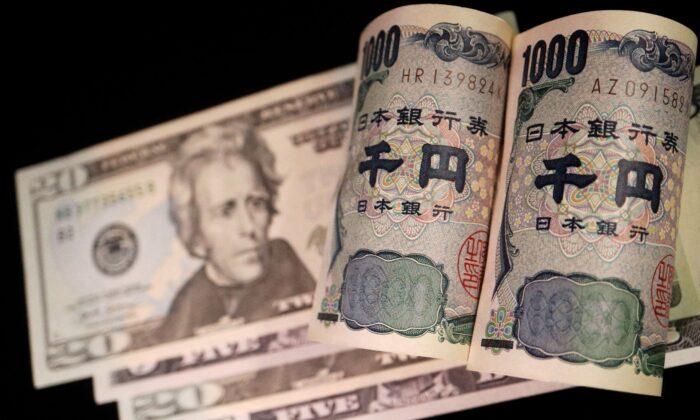LONDON—The dollar headed for a fourth weekly gain on Friday, pushing the yen to a 10-month low, as traders dialled back bets on how quickly the Bank of Japan might raise interest rates and how soon the Federal Reserve will cut them.
BOJ Governor Kazuo Ueda said on Friday there was a high chance for easy monetary conditions to persist even after the central bank ends negative interest rate policy, which the market expects to happen as early as next month.
That echoed dovish comments from his deputy, Shinichi Uchida, a day earlier that “it’s hard to imagine” that rates would rise “rapidly.”
In contrast, a raft of Federal Reserve officials this week have signalled the central bank has no pressing need to cut interest rates, thereby giving the dollar an extra tailwind.
“(Central bank officials) have all been singing from the same song-sheet and that is, yes, we are willing to fight inflation, but it’s too early,” Hargreaves Lansdown head of money and markets Susannah Streeter said.
“A word of caution is coming through that rates will stay higher for longer and early rate cuts are unfounded. That is giving the dollar extra strength ... That is what is propelling the yen weaker again.”
The yen was little changed at 149.42 per dollar after trading at 149.575 earlier, its weakest since Nov. 27. It is heading for a 0.68 percent slide this week, having fallen in value in five out of the last six weeks.
On Friday morning in Tokyo, Japanese Finance Minister Shunichi Suzuki said that he was “watching FX moves carefully,” uttering the well-worn phrase for the first time since Jan. 19. Traders were unfazed by the warning.
The dollar index ticked up slightly to 104.19, having gained 0.1 percent on Thursday after data pointed to the resilience of the U.S. labour market, further crushing expectations for an early rate cut from the Fed.
For the week, the dollar index has climbed 0.2 percent, getting off to a strong start after blowout monthly payrolls data last Friday and a hawkish tilt from Fed Chair Jerome Powell in a “60 Minutes” interview aired Sunday.
The next major scheduled U.S. data release is January’s Consumer Price Index (CPI) inflation reading on Tuesday.
Traders have all but ruled out a cut at the Fed’s next policy meeting in March, versus a chance of 65.9 percent a month ago, according to CME Group’s FedWatch Tool.
“While pricing for the March FOMC has been trimmed to negligible levels, there’s still latent upside fuel for the USD in pricing for FOMC meetings beyond that,” Richard Franulovich, Westpac’s head of foreign exchange strategy, wrote in a client note, predicting a rally toward 105.50 for the dollar index.
“We assume U.S resilience can extend well into 2024 ... and will make for a bumpy disinflation last mile.”
The euro was little changed at $1.0773, while sterling held around $1.2619. Both currencies have been relatively resilient, with officials from the European Central Bank and Bank of England pushing back against market wagers on early rate reductions.
The New Zealand dollar rose by as much as 0.73 percent earlier, supported by expectations for a delayed start to Reserve Bank of New Zealand rate cuts—or even the potential for further hikes—after data this week showed a stronger-than-forecast jobs market.
ANZ now expects quarter-point hikes both this month and in April as their main scenario, although February is a “line-ball call,” chief economist Sharon Zollner wrote in a note.
“If they don’t hike in February, we think they will in April, unless we start to see meaningful downside surprises,” she said.
The Aussie dollar was a touch stronger at $0.6505.
Leading cryptocurrency bitcoin rose 3 percent to around $46,688, on course for a weekly gain of 9.3 percent, its best performance in two months.







